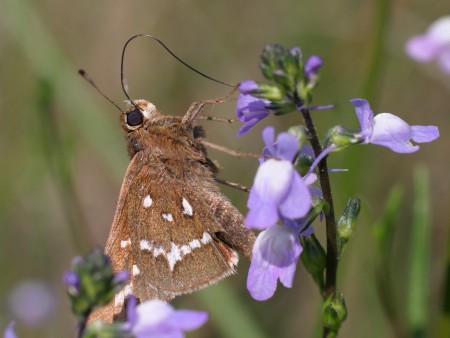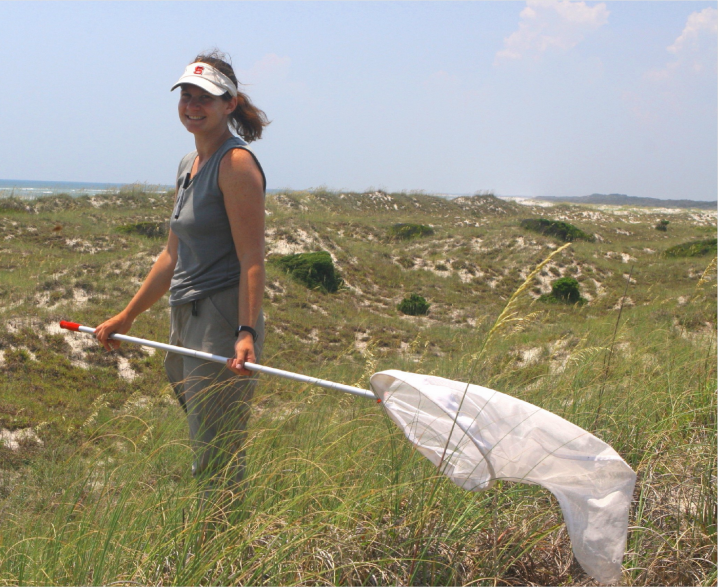
After years of research and debate, it’s official, or at least as official as these things can be: The world has a new species of butterfly, and its only certain and seemingly permanent home anywhere in the world is about a 30-mile stretch of sand dunes – as a butterfly flies – from Radio Island near Beaufort in Carteret County, down Bogue Banks in Carteret to Bear Island in Hammocks Beach State Park in Onslow County.
It’s not that the crystal skipper (Atrytonopsis quinteri) is truly new, at least not in the sense that it’s not been around. Sam Bland, a former Hammocks Beach park superintendent and now the naturalist for the N.C. Coastal Federation, has been talking about the skipper for quite some time and encouraging people to plant bluestem, a grass that grows amid the dunes and provides the habitat and the only known sustenance for the skipper caterpillar.
Supporter Spotlight
The crystal skipper was discovered, in fact, way back in 1978 in Fort Macon State Park in Atlantic Beach by Eric Quinter of the American Museum of Natural History. Quinter passed his findings on to John M. Burns, a world-renowned research entomologist with the Smithsonian Institution, who quickly realized the insect was a rare, and possibly new, find. Eventually the skippers were also spotted on Bear Island, although it’s not clear who found them there first.
In November, almost 40 years after the skipper was discovered, Burns published his paper making the case for a separate species in the Journal of the Lepidopterists’ Society that describes the crystal skipper as a full species, not just a subspecies of the skipper family. It came out at the end of November, after Burns, who is retired, used morphological and ecological analysis to determine that the butterfly was a full species.
After years of work, Burns said last week, there were several key findings that led to his conclusion. The caterpillar of the crystal skipper has a pattern on its head, whereas its nearest apparent “relative,” found on the mainland, doesn’t, he explained. The caterpillars of two species, Burns noted, also have striking color differences. Finally, despite their relative proximity to each other, the two species apparently have not bred, he said.
Burns put his research on the skipper aside for a while. “I was unsure, (and) I wouldn’t bet my life on the fact that they are separate,” Burns said. “In the field of taxonomy, all things are somewhat subjective. Things do change as more people do research, so decisions are not necessarily hard and fast. But from all the work I’ve done, I’ve concluded that, yes, it is a separate species.”
Burns’ work was aided greatly by Allison Leidner’s research at Fort Macon. She was working at the time toward her Ph.D. in biology at N.C. State University. She named the skipper after the Crystal Coast – the Chamber of Commerce name for Bogue Banks. The spots on its brown wings look something like crystals, she noted.
Supporter Spotlight
The U.S. Fish and Wildlife Service considers the crystal skipper a “species of concern” but it isn’t listed under the U.S. Endangered Species Act. The skipper, in fact, is a gigantic family of butterflies, so named for their quick, darting flight. There are, according to some sources, more than 3,500 species of them worldwide.
In fact, the crystal skipper is thriving, too, in a sense. It’s just that it thrives only in a very small area. But at least it has a cool name.
“Butterflies don’t really have formal common names, like birds do,” Leidner said. “But this name just took off.”

Children, for example, love it, she said, and get excited when they learn it’s unique to our area, and right under our noses, sometimes swooping around over beachfront backyards.
Leidner is understandably proud, but careful to point out that she neither discovered the crystal skipper nor did the paper that identified it as a full species. “It’s very exciting,” she said last week. “It’s amazing to have played a part in it. It’s not something that happens very often. It’s really unusual to find a new species of any kind in the United States.”
Leidner, who now work at NASA, has long focused on the ecology and conservation of rare and endangered species. And there’s no doubt that the crystal skipper is rare and that its existence, because of its limited range and its increasingly squeezed habitat, is tenuous.
As such, in a sense, it’s not just a butterfly, but something akin to a canary in a coalmine: As long as the crystal skipper is reproducing and flitting around the dunes in significant numbers, she said, one can be fairly sure that despite all the development and changes along its portion of the coast, at least some of the crucial dune habitat is healthy.
Leidner began her research on this little-known butterfly in 2004 to test questions she had about conservation strategies to reduce the consequences of habitat fragmentation. “After an initial field season the following spring, I was hooked,” she said.
Over the next five years, Leidner used field and genetic techniques to look at the effects of habitat fragmentation on the crystal skipper, with an eye toward identifying conservation strategies. Using a net and forceps, in a decidedly low-tech operation, she started collecting them for genetic analyses in the summer of 2006. She collected in spring and the summer to spread out the effects on the skipper population: the skipper’s lifespan as a butterfly is typically a matter of days, two weeks maximum. They almost surely number only in the thousands at any given time.
In addition, through catch-and-release and subsequent recapture, she learned that crystal skippers would leave their sand dunes and sometimes fly into parking lots, housing areas and forests. She even determined that they would move over a mile over a few days. But they always came back to those dunes, where the bluestem grows. The plant, unlike the skipper, ranges along much of the East Coast, and in the “Crystal Coast” region it’s the dominant species behind the dunes, growing back through the shrubs to the maritime forest, at least where the forest still exists.

The crystal skipper has two broods a year. The first emerges from the chrysalis stage in the spring, and the adults mate and the females lay eggs in the bluestem. The eggs hatch into caterpillars, which feed, grow and then undergo pupation to form a chrysalis. After metamorphosis, the second brood of adults emerge between mid- to late-summer. The caterpillars from this brood grow until fall, and then overwinter, and the following spring, the cycle begins anew.
Leidner now sees it as her mission, in part, to tell people the skipper’s story, and to help ensure the crystal skipper has a home. The skipper, said Leidner, should be protected because it has intrinsic value. By protecting its habitat – the sand dunes, we’re also protecting the development that lines Bogue Bank beaches, she noted.
“We need to protect that dune line,” she said, “and we need to do all we can” to keep people and pets from traipsing around within them, doing things like ‘sand surfing.’”
Folks who want to help the crystal skipper, Leidner added, might consider planting bluestem, much as people and conservation groups have taken to planting milkweed, the critical habitat for the most celebrated of our butterflies, the monarch.
“Some of the crystal skippers are fairly sedentary,” she said, “but our research also showed that some fly around, even into people’s backyards. We need patches (of bluestem) so that the habitat won’t become even more fragmented than it has already become.”
In essence, stepping-stones are needed, she said.
There have been formal efforts to do that. In 2009, Paula Gillikin, site manager for the Rachel Carson Estuarine Reserve in Beaufort, started a program aimed at growing bluestem. The plant has grown naturally in an area known as Bulkhead Shoal, but that area is eroding rapidly, plus the treasured wild horses in the reserve were trampling on the plant and eating it, too.
The idea of the program was to offset that habitat loss. In a pilot program in conjunction with the N.C. Aquarium in Pine Knoll Shores, bluestem was planted in a test area on Carrot Island. It worked, without fertilizer – a necessary precaution because of runoff concerns – but eventually the horses ate that, too.
So, Gillikin said, in 2011 another “crop” was planted and fenced off. Again, it worked. And it did attract some crystal skippers, though it’s not sure if they are, or will be a fixture there.

The project includes an interpretive sign, Gillikin said, and the goal is to inspire people to think, “Hey, if it worked there, maybe I could do it, too,” she said
The reserve also plans to teach children about the crystal skipper during a summer camp for rising seventh- to 10-graders this July, in conjunction with the N.C. Maritime Museum in Beaufort.
Participants will learn in the field how to mark and recapture butterflies and how to do some population dynamic studies. Best of all, Gillikin said, Leidner plans to come down from Washington, D.C., to teach, giving students the opportunity for contact with a high-level scientist.
All of this, Leidner said, is encouraging news for the ultimate survival of a tiny species that captured her heart years ago and remains important to her.
“People are excited about this,” she said of the butterfly. “They care.”
Burns said he was relatively confident that the crystal skipper can endure, thanks, again, in large part to its stronghold in those at least theoretically undevelopable state parks, especially Hammocks Beach, in which is Bear Island is accessible only by boat. His main worry, he said, would be if a major hurricane – a Katrina-type event – roared through the region and leveled the dune habitat for miles, through the range of the species.
“Other than that, as long as we have those state parks, which are of considerable size, I’d think they will last,” he said.
Learn More








